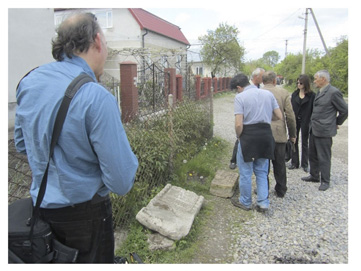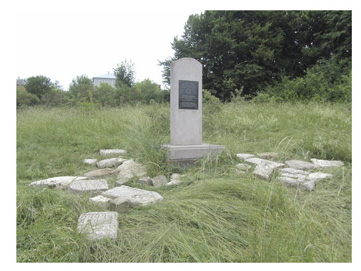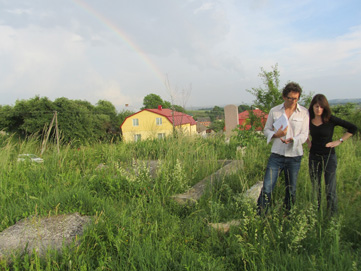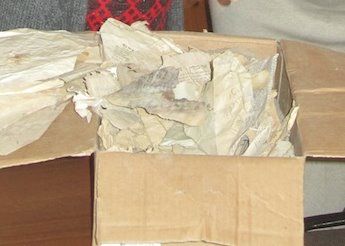
Traces:
What Remains of a Life
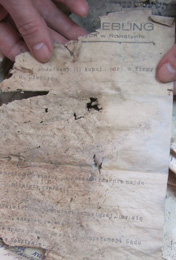
of Rohatyn
What material, tangible evidence remains of a person's life when that life is over? Can I, the great-grandchild or great-great-grandchild of a person who died 50 years before my birth, today find a piece of that person's life? Can I walk the streets of the Old World—my ancestor's world and find a physical imprint of that person's former presence? These are questions that have always intrigued me, even as a child when I would press elderly grandparents and cousins for family stories, town descriptions, photos, and memories, but rarely receive anything other than a casual but kindly dismissal that "nothing still exists,” that "everything disappeared,” or that "no one wants to remember.” Like many budding genealogists, I, too, heard that the town from where part of my family came—the town where my Horn and Liebling families had lived (and died) over multiple generations—was no more. Gone. Disappeared. Destroyed. No longer on the map. How could that be possible? How can a person live a life—in all its complexity, personal and historic—only to then disappear completely from this world, leaving not a trace behind? Finding answers to these questions ultimately propelled me in 2008 to travel to a little Galician town named Rohatyn, located today in western Ukraine, and to return six more times between March and September 2011. First Visit to Rohatyn—Laying the Groundwork Culled mostly from JewishGen databases (birth, death, burial, aliyah passports, holocaust records, etc.), I went armed with some hard "facts" for my various journeys. I also had notes and letters from conversations with family members and various others (all now deceased) who had been born in Rohatyn or had known my Rohatyn family. But what I really wanted was to find an "imprint" in the world of today, of a life from yesterday. Would I? Could I? The first trip in the winter of 2008 provided for me the visual reality for what had until then only been abstract storytelling. I could now walk its streets and see the physical layout of the town with its various commercial and residential buildings and its two former Jewish cemeteries, largely now destroyed. A town called Rohatyn now became for me a real place, and when I thereafter thought about events in the past lives of my Rohatyn grandmother, great-grandfather, great-great-grandparents, and the extended Horn family, I could roughly imagine where in town events might have taken place. I had no concrete information about places specific to my Horn family other than the tentative identification of a few buildings that may have been their businesses on the rynek (commercial area); and some of that information was contradictory and confusing because the town had changed a lot since the War. I knew that in 1998 two memorials had been erected and dedicated to the 3,500 Jews of Rohatyn murdered by the Nazis, but never found them on this visit, largely because of wintry weather, lack of reliable maps, our inability to speak Ukrainian, and the remoteness of the location at the mass grave sites on the outskirts of town where the memorials had been placed. Once back home in Paris, we subsequently created a webpage that described this 2008 trip, posted maps and photos, and provided links to JewishGen's Rohatyn Shtetlinks page so that others traveling thereafter to Rohatyn might arrive armed with more specific information on Jewish historic sites.
Return to Rohatyn—An Emerging Sense of Purpose In 2009 I was invited to join a newly-formed Rohatyn Research Group after the group's founder saw our webpage. Today, that group has over 150 members, living in half a dozen countries worldwide. Members share records, photos, discussions, and musings. A number of members gathered at the IAJGS conferences in Philadelphia and Los Angeles and several group members have been (or have plans of going) to Rohatyn. By March 2011, I, too, was ready to return. My husband and I rented a furnished apartment for three months in Lviv, Ukraine, less than a two hours’ drive west of Rohatyn. Our plan was very simple: make a trip or two by car to Rohatyn, find the mass grave memorials, shoot some more photos, and maybe even meet the town's new librarian, a young man named Ihor Klishch who spoke English and had posted on the internet several videos promoting the library's resources. Seeking the physical traces of my family's past in Rohatyn was not to be our focus, as, after all, we had already been there in 2008 and the town had changed so much in the years since my family had walked its streets. Street names and numbers had repeatedly changed making it nearly impossible to correlate to the information I had brought with me in 2008. Building facades had been redone and the cemeteries were still overgrown and decrepit with few remaining headstones. The memorials at the mass grave sites were still an intellectual abstraction, and it was difficult to comprehend the horror they physically memorialized, even knowing that I had family members in those graves. No, I did not expect to find traces. At best, I hoped to find a few records in the Lviv archives. As a fairly seasoned genealogist and realist, I had no preconceived expectations in visiting Rohatyn again. I would be content if I was lucky enough, with the help this time of Ihor, if we could merely solidify our recollection of the layout of the town and perhaps meet with some of its current residents, all of whom were born too late to have known my family when they had lived there, too.
In the three months that followed, we made five visits to Rohatyn, mostly on our own with a rental car, a few times with members of my Rohatyn Research Group, and once with Renaud Lavergne, a Frenchman working for AFP (Agence France-Presse)who was writing an article on Jews making trips to Galicia from America, France, Israel, and other countries . Sometimes we also had Ukrainian friend and fellow researcher Alex Denysenko with us. Ihor of the Rohatyn library was present at every one of our visits, none of which could have been possible without him as translator and coordinator. In all, we toured the Rohatyn library and museum, met with Rohatyn's Mayor, were interviewed by Ukrainian TV, spoke with the Priest of the local Ukrainian Church, and spent invaluable hours with the town's historian, Mr. Vorobets, whose knowledge and presence brought to our attention one of the most important "traces" of former Jewish Rohatyn life—the headstones and headstone pieces removed from the cemeteries by the Nazis 65 years ago and remaining today scattered about the town. On our initial visit to Rohatyn during this 2011 trip, we located the two mass grave sites and memorials, which we had not found in 2008. While at the northern memorial site, we were unexpectedly visited by a Ukrainian man named Mikhailo who rode up on a horse-drawn cart. He told us he was 12 or 13 when the horrors on this ridge unfolded on March 20, 1942, and he had memories he wanted to share with us. We were grateful to have had Alex with us so he could translate Mikhailo's recounting. Traces—here in the form of oral testimony—brought the past to the present. Suddenly, some of the victims of this fateful day—one of three "Aktions" 70 years ago—now came to life on this lonely, windy crest in the fields. These victims had faces and physical descriptions and in some cases names (because they were known to Mikhailo), and he relayed the gruesome accounts of their last moments of life.
On our second visit, we met Mr. Vorobets. He had been a young child during the height of the War. He heard and saw things but did not comprehend them at the time, filling in his understanding when older. A school teacher at the local Ukrainian gymnasium, Mr. Vorobets had assembled over the years some historical details about families, houses, occupations, and life in the Jewish community, as part of his larger work collecting history of the town. He allowed us to scan some of his documentation (all written in Ukrainian, of course), which included:
Some of these traces produced exciting information—Horn family students in 1912!; some held painful memories—stories of Jewish children and families hiding in the War and denounced; some were crying out for remembrance and reconciliation between the past, the present, and the future. Perhaps most importantly, however, was the list Mr. Vorobets had compiled over the years of Jewish headstones still found around town today, with details of their locations under planted gardens, in walls and foundations, behind the Rohatyn Courthouse. Here they were, the traces of past lives. Future Rohatyn visits suddenly had a clear purpose that had been revealed from the unanticipated revelation of these traces from the past: the headstones. The focus would be—HAD to be—to locate, photograph and document these headstones, and then arrange to move them to one of the former Jewish cemeteries for safekeeping and future study. Rohatyn Research Group founder Alex Feller accompanied us on our third visit. The number of headstones found in and around town had grown since our last visit, and there seemed to be no end in sight. People were talking. Even while photographing the dozen or so we already knew about from Mr. Vorobets, more elderly Rohatyners would arrive to watch, talk, and walk Mr. Vorobets and us to their gardens, farms, driveways, walls, houses, river banks, etc., where more headstones were stacked, half-buried, or merely forgotten yet visible. We were led to several streets where the Nazis had ordered that the walkways be paved with headstones. Headstones and fragments were scattered along creek banks, some half-buried, half-exposed along road sides. Some were still legible, some not. Many photos were taken over that two-day, emotional visit. It now seemed as though the traces—these hundreds if not thousands of headstones and headstone fragments—each represented voices of the past, calling out for remembrance. More traces than we had ever imagined.
We met with the Mayor who promised to issue permits, wherever needed, to excavate and move headstones as they are found and identified by the townspeople. We arranged with Mr. Vorobets to act as coordinator of this project, and committed to fund the transportation and relocation costs. No one yet knows the full extent of this project. Our fourth and fifth visits included more members from the Rohatyn Research Group (including Alex Feller and Alex Denysenko again) and AFP reporter Renaud Lavergne. During our fourth visit, Alex Feller and I gave an interview to Ukrainian TV with Alex Denysenko acting as translator. Now more people would learn of the project through TV. That day, we also found three more headstones while walking around town with Mr. Vorobets, brought to his attention by passers-by. We took four small ones to the cemetery ourselves. On the fifth and what we thought would be our final visit, we met with the local Priest who by then had also heard about the headstone project and agreed to speak with his parishioners. We also were able to enter several buildings with important significance for Rohatyn's Jewish past, which included the Judenrat building, today a school for orphans and disabled children, formerly located within the Rohatyn ghetto. Even though we had not notified the school that we hoped to see the interior of this building, Mr. Vorobets found the school Director and he took us inside. Once inside, and although his time was pressed by prior engagements, the Director excitedly announced that he had something to show us. More traces, I asked myself? What could he possibly have? The Director returned with a box containing scores of crumbling, moldy, faded, browned, stained, and brittle scraps of miscellaneous "Jewish" pieces of paper that had been found during a recent renovation of the school. Some appeared to be printed pages from Hebrew bibles or books; others were pieces of hand-written notes, as from notebooks; others were pieces of paper bags or business receipts; a few appeared to be ration cards or food coupons; and a few had readable surnames and signatures; some also had dates from the 1941-42 period during the ghetto and the Nazi occupation. One nearly full sheet was on business stationery on which I could read "Liebling" printed at the top. Another of my past Rohatyn family, one that did not survive the Shoah.
We left Rohatyn feeling the ties of the past—ties that now bind us forever to the place. Ties created by the traces we had found over the last three months: scraps of papers; school lists; oral testimonies; headstones. Visiting the Lviv Archives During our three months in Lviv, we also visited the Lviv Archives, bringing with us lists of records with connections to Rohatyn obtained from multiple sources, including JewishGen, JRI Poland, and Gesher Galicia. This visit required advanced planning as one cannot just walk in and make a request—a letter of introduction is necessary explaining the purpose of the visit and the intended use of the records. Alex Denysenko helped with this aspect. We met with Lviv Archive Director Diana Pelts, who treated us with respect and professionalism and spoke both English and French. Although most of the records we requested and received did not produce anything of particular interest regarding the Rohatyn Jewish families being researched by me or other members of the Rohatyn Research Group, one record did: an 1820 hard-bound book of entries of Rohatyn property owners. We excitedly requested to photograph the first 40 pages of this book (where most of the Jewish names appeared, closest to the rynek), got the request approved and pre-paid, then set about our task of shooting digital photos. Not only was there an entry for a member of my own family—Mendel Horn, in House #128—but dozens of others whose Jewish names I recognized. Traces again—in this case, a line in a nearly 200-year old book—that there once lived a member of my Rohatyn family in the same house shown on several birth and death records I had obtained from Warsaw using JRI Poland's AGAD records. I may not yet know exactly how these generations of family members were related to each other (and to me), but I know now from these records that House #128 was in the Horn family into the 20th century. Proof that my grandmother's stories were true, that she had been born in the same house in Rohatyn as her father and as his father's father. Traces of those that preceded me, here, now in my hands. Chodorow is another Galician town in which my Rohatyn family has connections—a town we hoped to visit by car, located between Lviv and Rohatyn. But to be meaningful, I needed an inter-War map showing the street names when they were still Polish. I had not had luck finding such a map, so on a long-shot, returned to the Lviv archives. My research using JewishGen and Gesher Galicia resources showed that the archives had two Chodorow cadastral maps, one for 1928 and one for 1933. We ordered them, knowing that Gesher Galicia was also interested in photographs of the maps for its records. The maps arrived as promised from storage at the archives the next day, but to my disappointment, contained no street names whatsoever. What we got were large cadastral maps and a couple of odd ledger sheets rolled up along with the 1928 cadastral map. After about two hours of shooting pictures for Gesher Galicia, and the very last thing we did for the day, we unrolled one of the brittle hand-written ledger rolls. Looking up at me from the table, I spotted "Rohatyn" in one of the columns; beside that, in another column, the entry "Horn-Liebling." Further right in yet another column appeared "Josef Horn," my great-great-grandfather, followed by his actual signature! This time it was serendipity at work—to be at the archives for another stated purpose—revealing to me more traces of lives my family once lived, but on this occasion, by one with a more direct, meaningful connection to me, of a person about whom I had heard through my grandmother. Here was my great-great-grandfather, on an odd, brittle sheet of paper that had been used as wrapping around a 1928 Chodorow cadastral map which we almost didn't consider even opening, calling out to say, "I lived. I once did business here."
Once More in Rohatyn In mid-September 2011, my husband and I returned to our former apartment in Lviv and stayed for an additional two months, making three more trips to Rohatyn. Ihor had left his employment at the Rohatyn library, but a new face in town appeared, this time an American Peace Corps volunteer, Abe Lyons, who ably assisted as translator during our meetings with Mr. Vorobetz. Over the three months since our last visit to the town, more Jewish headstones and fragments had been found, particularly where the City had initiated sewer replacement work. The Rohatyn Deputy Mayor spent an afternoon with us walking neighborhoods and locations where the latest headstone fragments had been discovered. He also arranged for us to get inside the vacant building that once was Rohatyn's largest synagogue. As for the box of Jewish paper scraps, collected and shown to us during our last visit by the Rohatyn school Director, they found a new home—at Hesed-Arieh, a Jewish organization and museum located in Lviv. In November 2011, the school Director came to Lviv with a dozen of his students, and during an informal ceremony attended by me, my husband, and the Directors of Hesed, the box was donated. At present, the hundreds of paper scraps—artifacts of Jewish lives during the Nazi occupation—are being digitized by Hesed's staff for preservation and translation; and Alex Denysenko, on behalf of my Rohatyn Research Group, has been in discussion with Yad Vashem about creating an exhibition for these Jewish papers, that would give voice in the present to these lost lives of Rohatyn's Jewish past. Finding the Traces So, what remains of a life after that life has ended? Here is my answer. That physical traces can be found—sometimes by pure chance, or by being at the right place at the right time; sometimes by persistence and repetition and by gaining the trust and friendship of those who work the archives, run the libraries, conduct the Church services, or are local historians or personalities. In all cases, these traces, whether they be records, shreds of paper in a box, notes from an oral history, or forgotten headstone fragments, are like a muffled voice calling out to you from far away, saying, "I was here. I too had a life that was real and meaningful. Look, here I am, even today, in this list of students from when I attended the Red School or the Ukrainian school in 1924;, in this land records book—see, I lived in House #128 in 1820, as did your great-grandfather after me, and his son, and his daughter, who was your grandmother; on this headstone fragment that has been lying face down on a creek side for the last 65 years." These traces are what make the past real for the present. The life itself may be gone, but it is not forgotten. March 2012
|
|||||||||||||||||||||||||||||||||||||
